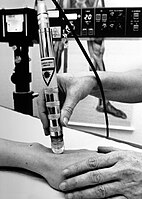
Photo from wikipedia
OBJECTIVE To assess the efficacy of low-level laser therapy (LLLT) with different wavelengths and transcutaneous electric nerve stimulation (TENS), and explore the optimal wavelength range of laser application in the… Click to show full abstract
OBJECTIVE To assess the efficacy of low-level laser therapy (LLLT) with different wavelengths and transcutaneous electric nerve stimulation (TENS), and explore the optimal wavelength range of laser application in the treatment of pain caused by temporomandibular disorders (TMD). METHODS An electronic search on PubMed, Cochrane Library, Embase, Scopus, and Web of Science was undertaken to identify the randomized clinical trials (RCTs) published from database inception to 16 April 2021, aiming to compare the effects of LLLT with different wavelengths (632.8-672nm, 780-904nm, and 910-1100nm) or TENS or placebo group on TMD patients' pain reduction. In addition, manual search of the studies was performed. The reviewers assessed the risk of bias of individual studies with the Cochrane risk of bias tool and excluded the RCTs with a high risk of bias in any field. Meanwhile, the reviewers, after performing the network meta-analysis, assessed the quality of evidence which contributed to network estimate via the GRADE framework. RESULTS 27 RCTs with 969 patients with TMD were included. In the meta-analysis, all treatment groups showed an overall improvement in pain scores, when compared with the placebo group. LLLT with wavelength ranging from 910nm to 1100nm produced more pain relief in the visual analogue scale (VAS) immediately after treatment [mean difference (MD)=4.68, 95% confidence interval (CI):(3.08,6.28)]. After one month follow-up, LLLT with wavelength ranging from 910nm to 1100nm also showed superior pain-relieving effects [MD=3.61, 95% CI: (-1.77, 8.99)]. However, no significant difference was observed. Based on the SUCRA ranking, L3 ranked first immediately after treatment and one month later. CONCLUSION The results of the meta-analysis showed the LLLT had better short-term efficacy than TENS in the treatment of pain caused by TMD. Better results can be achieved with higher wavelengths. Therefore, we recommended to treat TMD using LLLT with wavelength ranging from 910nm to 1100nm.
Journal Title: Journal of oral rehabilitation
Year Published: 2021
Link to full text (if available)
Share on Social Media: Sign Up to like & get
recommendations!